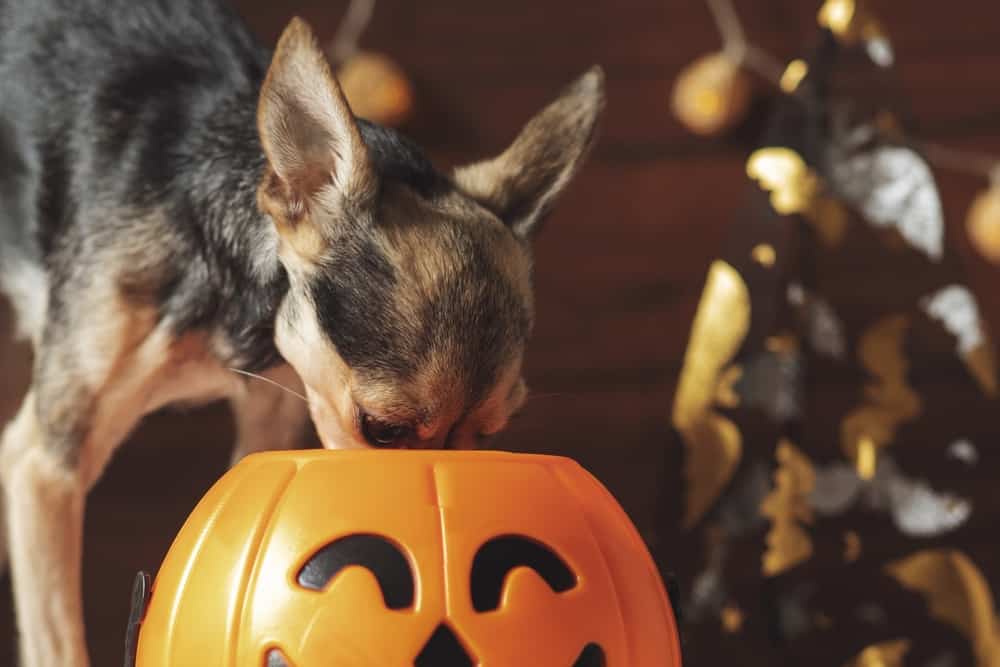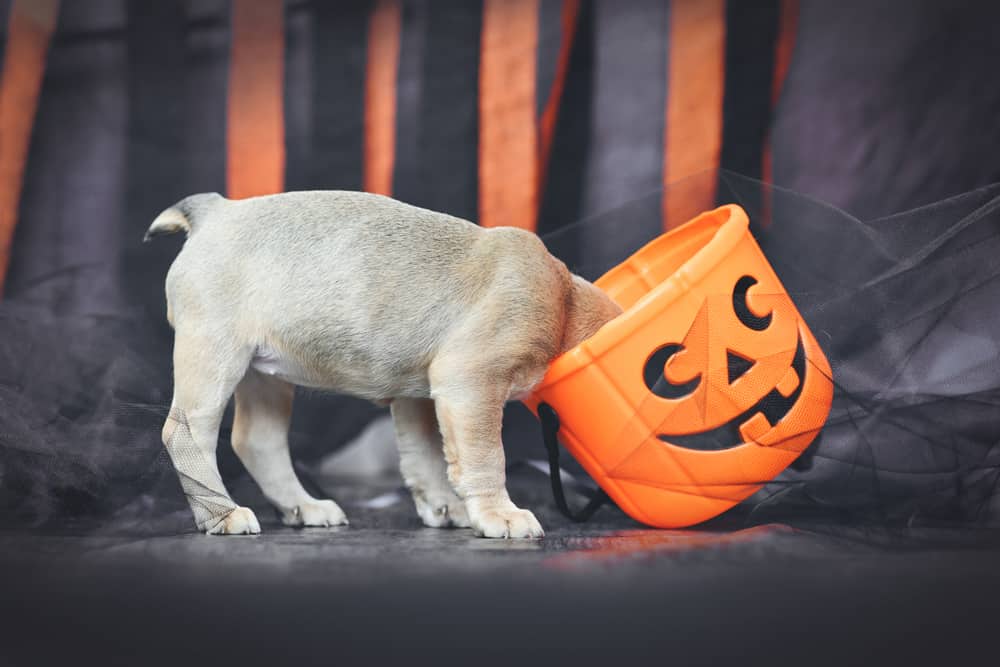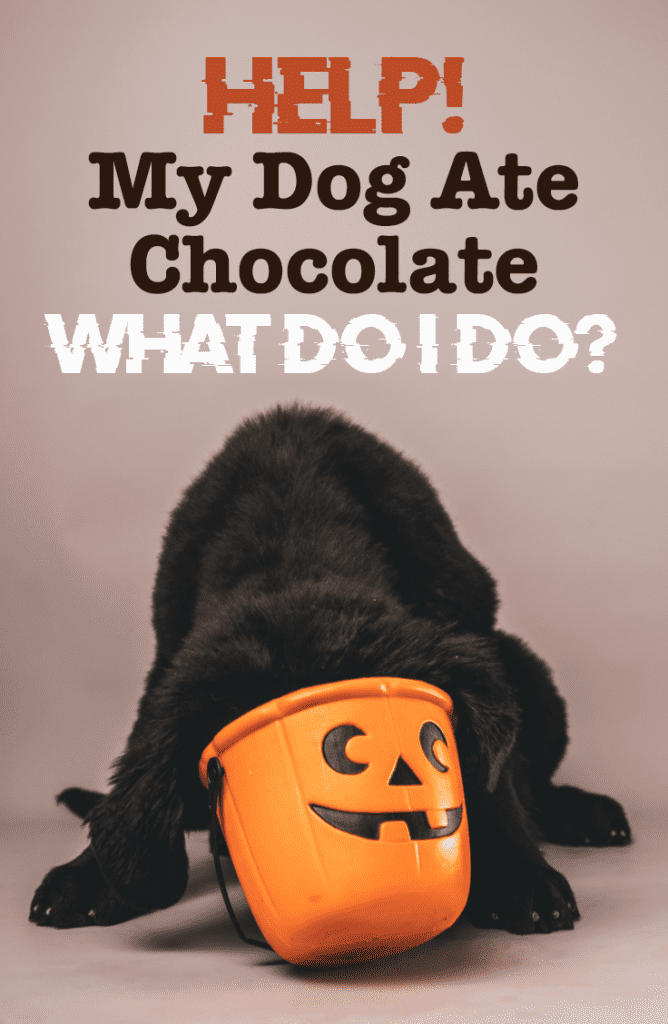“This post contains affiliate links, and I will be compensated if you make a purchase after clicking on my links.”
While you’re celebrating this spooky season with your dog, be cautious of a dangerous toxin lurking within those chocolatey Halloween treats.
Most dog owners are aware that chocolate is a big no-no for dogs. However, the amount and the type of chocolate a dog ingests make a huge difference in how your dog will be affected by it. While the random chocolate chip in a cookie is usually not an issue, certain kinds of chocolate are highly toxic to pooches.

In most cases, the more bitter and darker the chocolate a dog has ingested, the greater the risk of your dog getting poisoned. The amount of chocolate a dog can ingest without serious adverse effects is relative to the size of the dog as well. Where an 85-pound Labrador may show no reaction to eating a few candies from your plastic pumpkin candy-catcher, a 4-pound Chihuahua may be seriously at risk.
The toxicity of chocolates is generally caused by a chemical that’s a relative of caffeine known as methylxanthines. This triggers diarrhea, vomiting, lethargy, hyperactivity, increased thirst, agitation, seizures, abnormal heart rate, and sometimes death.
Also, with as low as 20 mg/kg of theobromine, another chemical compound in chocolates that is indigestible to dogs, clinical signs of canine poisoning can already be observed in your pet. Amounts of theobromine ingested that is greater than 40 mg/kg can result in cardiotoxicity which is characterized by racing heartrates or heart arrhythmias. Worse, if your dog has consumed amounts of chocolate with this chemical greater than 60 mg/kg, neurotoxicity would be a potential risk. A poisoned nervous system can lead to tremors, seizures, and/or even death.
If you’ve turned to this article because your dog ate chocolate and you’re concerned for his or her health, enter your dog’s information and the type and quantity of chocolate eaten to determine how toxic a serving he had.
Chocolate toxicity calculator courtesy of PetCare.com.au.
Signs of Chocolate Toxicity in Dogs include:
• Vomiting and Diarrhea – These two problems are the earliest signs of chocolate toxicity in dogs. In light cases, dogs may simply vomit or have diarrhea a few times and then feel better. However, in severe cases, these symptoms may progress further to the others on the list below.
• Excessive Thirst and Urination – Since both theobromine and caffeine are diuretics, found in ALL types of chocolate, dogs may show both excessive thirst and urination when they have ingested too much of either of these substances.
• Restlessness – Caffeine, in particular, may cause dogs to behave restlessly. Darker chocolates with higher caffeine content may lead to this symptom even without the dog ingesting very much of it.
• High Heart Rate – An elevated heart rate is a dangerous symptom that could lead to cardiac arrest, especially in older dogs or those with underlying conditions. It can be difficult to monitor your pet’s heart rate at home, so it may be advised to take your dog to the emergency vet right away for monitoring and/or treatment.
• Seizures – Seizures are one of the most severe symptoms of extreme chocolate toxicity in dogs. This may only occur when a dog has ingested a large quantity of chocolate, but it can sometimes mean the toxicity will become fatal without veterinary treatment. Take your dog to the vet right away if he shows this symptom after eating chocolate.
What You Should Do
Dogs that have finished off small amounts of chocolate may show signs of poisoning in about a day or two while dogs that have eaten large amounts of dark, more toxic chocolates will demonstrate signs of toxicity in just a matter of hours. While both cases require medical attention, the latter is a highly urgent situation that, if not treated right away, could lead to serious life-threatening illnesses.
Treatment generally includes your vet trying to induce vomiting which usually depends on when your dog ingested the chocolate. They may then administer activated charcoal numerous times so the toxins pass through the dog’s digestive tract, prescribe anti-nausea drugs, and possibly give IV fluids and heart medications.
Don’t forget that with any kind of canine poisoning, it’s always less expensive, less severe, and has a much better outcome if early treatment is done. Since there is no antidote to chocolate poisoning, prevention is always better than cure.

Tips to Prevent Chocolate Toxicity in Dogs
• Better Storage – Keep cabinets and pantry doors shut whenever possible and don’t leave chocolate treats or wrappers sitting around.
• Train your pet the “leave it” command to prevent them from grabbing things they shouldn’t, be they edible or inedible.
• Educate Friends and Family not to give your dog any chocolate or other sweets and get them into the habit of storing things in their proper place.
• Always avoid using cocoa shell mulch for your landscaping – often used as a top cover for gardens, its sweet aroma can be attractive to dogs and result in them ingesting some of the mulch, which can cause illness.
Found this article helpful? Pin it!
























